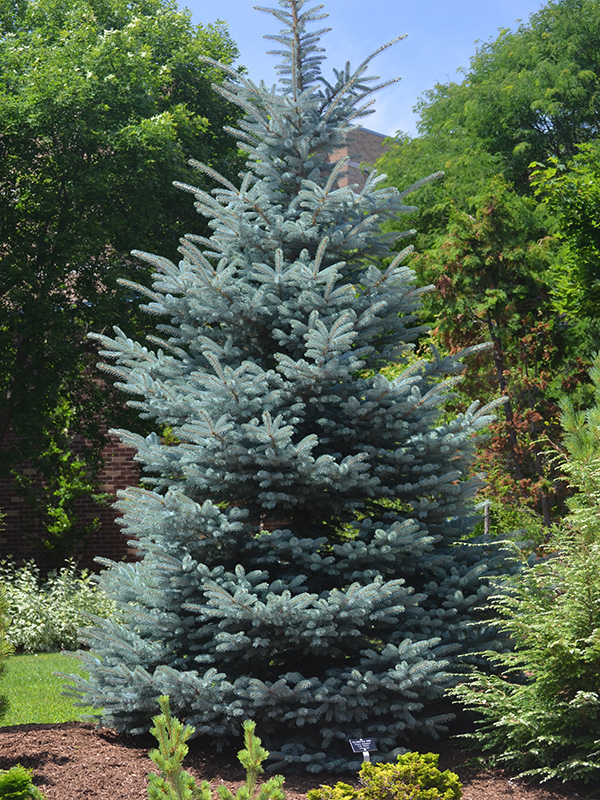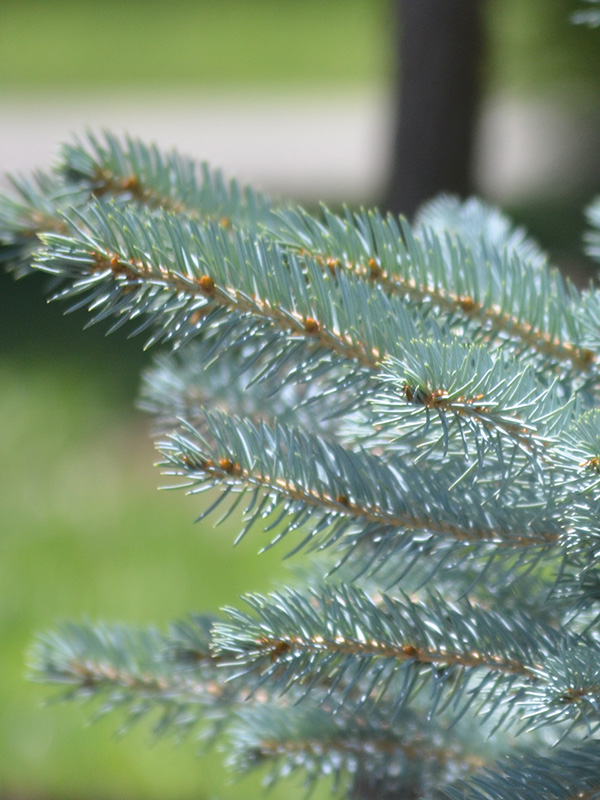
Woody > Picea > Picea pungens > Picea pungens f. glauca 'Fat Albert'
Picea pungens
f. glauca 'Fat Albert'
Fat Albert Colorado Spruce
Origin: Fat Albert Colorado Spruce was introduced in 1978 by the Iseli Nursery in Oregon, USA. It was a product of natural crossing that was discovered growing among the other spruce trees. It was named 'Fat Albert' by Don Howse, a good friend of nursery founder Jean Iseli. 'Fat Albert' was in relation to the well-known cartoon character from the comedy series “Fat Albert and the Cosby Kids”.
Mike's
Opinion


"
Picea pungens 'Fat Albert' is a cultivar well known for its uniformity of shape as well as its distinct silvery blue colour. Not only does it provide great winter interest, but it is also a very adaptable backdrop with shrubs and perennials in the warmer seasons. Its drought and deer tolerant qualities make it the ideal tree for a home garden. Its full pyramidal feature also provides a good shelter for birds. It is a low maintenance tree that requires no staking or training and under ideal conditions it can be expected to have a life span of 80 years or more.
Michael Pascoe, NDP., ODH., CLT., MSc. (Plant Conservation)
"
| Family |
| Pinaceae |
| Genus |
| Picea |
| Species |
| pungens |
| Cultivar |
| 'Fat Albert' |
| Category |
| Woody |
| Type |
| Tree (evergreen) |
| Forma |
| glauca |
| USDA Hardiness Zone |
| 3 - 7 |
| Canadian Hardiness Zone |
| 1a - 7a |
| RHS Hardiness Zone |
| H5 - H7 |
| Temperature (°C) |
| -40 - (-12) |
| Temperature (°F) |
| -40 - 10 |
| Height |
| 4 - 5 m |
| Spread |
| 3 m |
Photographs
Description and Growing Information
Flowering Period
| General Description |
| Picea pungens 'Fat Albert' or Fat Albert Colorado Spruce is a slow growing dwarf evergreen tree, known for it's broadly rounded and upright shape. It is similar to Picea pungens 'Montgomery' but can grow to be nearly twice as tall. |
| Landscape |
| Often used as a specimen or accent plant in home gardens. Can be used in group plantings because of its colour consistency. Also used in xeriscaping because of its drought tolerance. |
| Cultivation |
| Prefers slightly acidic, moist soil though it is drought tolerant. Ideally grown in full sun; good drainage is required. Highly tolerant of salts and other urban pollution and has been known to thrive in city environments. |
| Shape |
| Densely pyramidal with a broad base starting fairly close to the ground and a naturally straight central leader. |
| Growth |
| Slow |
| ID Characteristic |
| A dense evergreen with a distinct pyramidal form, strong central leader and very pointy silvery-blue needles. |
| Pests |
| This cultivar is quite resistant to pests and diseases. |
| Habitat |
| Horticultural origin. |
| Bark/Stem Description |
| Quite rough and scale-like, grey-brown. New shoots are vivid orange. |
| Flower/Leaf Bud Description |
| About 1 cm in length, loosely scaled and vivid orange. |
| Leaf Description |
| Needles are very stiff and sharp reaching about 3 cm in length. They are almost square in shape and equally distributed on the branches in a perpendicular fashion. Their rich silvery-blue intensifies both on new growth and in the winter season. |
| Flower Description |
| A non-flowering cultivar. |
| Fruit Description |
| Sterile. |
| Colour Description |
| Bark is a light grey-brown, new shoots are orange, needles an intense blue. |
| Texture Description |
| Medium texture: bark and needles are fairly rough. |
| Notable Specimens |
| The Gardens of Fanshawe College, H Building courtyard, London, Ontario, Canada. |
| Propagation |
| By grafting. Scions are grafted onto dormant Picea abies rootstock during the winter months in particular January / February. During grafting, plants should be kept in a humidity frame which allows for higher water potential and less stress during the process. Soaking scion bases in 200 ppm IBA for three minutes before grafting is beneficial. Air layering has also been proven successful. |
References
Lonnee, Debbie; Rose, Nancy; Selinger, Don; Whitman, John. Growing
Shrubs and Small Trees in Cold Climates. University of
Minnesota Press. 2011. (Lonnee, Rose, Selinger & Whitman, p.
199-204)

